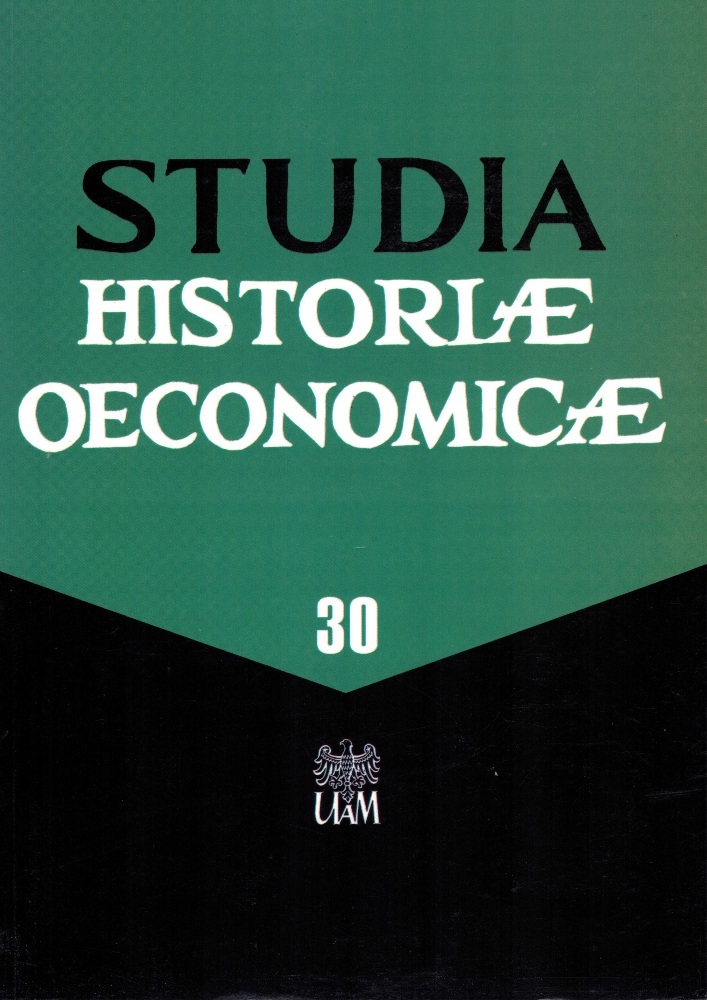Abstract
The second part of 19th century and the beginning of 20th century is a time of rapid growth among labour unions in the United States. During this period labour unions and associations changed from trade unions to common unions accepting a wider spectrum of workers. In this article, I present the development of the labour legislation in the United States from the point of view of the labour union postulations, starting from the first regulations through to the legislation of the New Deal era. I focus on three specific areas: the child labour problem, the minimum wage question and the working hours regulations. Along these lines, I compare labour union and workers association postulates with state and federal legislation and the solutions of problems, from the beginning of American labour unions to the New Deal era.
References
Adamson Act of 1916 (2009) Washington: Great Neck Publishing.
Fair Labor Standard Act of 1938, as amended (2004) Washington: U.S. Department of Labor, Employment Standards Administration, Wage and Hours Division.
National Industrial Recovery Act (1933) Washington: U.S. Govt. Print. Off.
Arnold, A.B. (2007) ‘Anthracite Coal Strike (1902)’, in Arnesen, E. (ed.) Encyclopedia of U.S. Labor and Working-Class History. Vol. 1. New York: Routledge, pp. 113–115.
Calavita, K. (1984) U.S. Immigration Law and the Control of Labor, 1820–1924. New York: Academic Press.
Choudhry, S. (2004) ‘The Lochner Era and Comparative Constitutionalism’, International Journal of Constitutional Law, 2(1), pp. 1–55, http://www.law.utoronto.ca/documents/Choudhry/Lochner_Comparative_Constitutionalism.pdf. Accessed 30 May 2011. DOI: https://doi.org/10.1093/icon/2.1.1
Costa, D.L. (2000) ‘Hours of Work and the Fair Labor Standard Act: A Study of Retail and Wholesale Trade, 1938–1950’, Industrial and Labor Relations Review, 53(4), pp. 648–664. DOI: https://doi.org/10.1177/001979390005300405
English, B. (2007) ‘National Child Labor Committee’, in Arnesen, E. (ed.) Encyclopedia of U.S. Labor and Working-Class History. Vol. 3. New York: Routledge, pp. 945–947.
Faulkner, H.U. (1943) American Political and Social History. New York: Appleton-Century-Crofts.
Faulkner, H.U. (1960) American Economic History. New York: Harper Collins.
Faulkner, H.U. and Starr, M. (1957) Labor in America. New York: Harper and Brothers Publishers.
Felt, J.P. (1970) ‘The Child Labor Provisions of the Fair Labor Standards Act’, Labor History, 11(4), pp. 467–481. DOI: https://doi.org/10.1080/00236567008584139
Jones, R.D. (2003) ‘National Industrial Recovery Act (NIRA) 1933’, in Schlager, N. (ed.) The American Economy: A Historical Encyclopedia. Vol. 1. Santa Barbara: ABC-Clio, p. 198.
Lause, M. (2007) ‘Philadelphia Journeymen Conspiracy Strike (1806)’, in Arnesen, E. (ed.) Encyclopedia of U.S. Labor and Working-Class History. Vol. 3. New York: Routledge, p. 1083.
Leiter, R.D. (1951) ‘Federal Regulation of Child Labor’, American Journal of Economics and Sociology, 10(3), s. 293–300. DOI: https://doi.org/10.1111/j.1536-7150.1951.tb00055.x
Lewis, J.G. (2007) ‘Department of Commerce and Labor’, in Schlager, N. (ed.) St. James Encyclopedia of Labor History Worldwide. Vol. 1, pp. 237–238.
Luce, S. (2007) ‘Minimum Wage Laws’, in Arnesen, E. (ed.) Encyclopedia of U.S. Labor and Working-Class History. Vol. 3. New York: Routledge, p. 899.
Messer-Kruse, T. (2007) ‘Steward Ira’, in Arnesen, E. (ed.) Encyclopedia of U.S. Labor and Working-Class History. Vol. 3. New York: Routledge, pp. 1328–1329.
Northrup, C.C. (2003) ‘Child Labor’, in Schlager, N. (ed.) The American Economy: A Historical Encyclopedia. Vol. 1. Santa Barbara: ABC-Clio, p. 44. DOI: https://doi.org/10.5040/9798216190707
Perlman, S. (1921) ‘Upheaval and Reorganizations (since 1876)’, in Commons, J.R. (ed.) History of Labor in the United States. Vol. 2. New York: Macmillan, p. 357.
Rayback, J.G. (1966) A History of American Labor. Expanded and updated. New York: Free Press.
Scheiber, M.N., Vetter, H.G. and Faulkner, H.U. (1976) American Economic History. New York: Harper & Row.
U.S. Industrial Commission (1905) ‘Hours of Labor [final report 1901]’, in Trade Unionism and Labor Problems. Boston–New York–Chicago–London: Ginn and Company, pp. 454–481.
Walker, R.W. (1970) ‘The A.F.L. and Child-Labor Legislation: An Exercise in Frustration’, Labor History, 11(3), p. 323–340. DOI: https://doi.org/10.1080/00236567008584128
Whittelsey, S.S. (1905) ‘Massachusetts Labor Legislation’, in Commons, J.R. (ed.) Trade Unionism and Labor Problems. Boston–New York–Chicago–London: Ginn and Company, pp. 482–508.
Zieger, R.H. (1968) ‘From Hostility to Moderation: Railroad Labor Policy in the 1920’s’, Labor History, 9(1), pp. 23–38. DOI: https://doi.org/10.1080/00236566808584029
Zonderman, D.A. (2007) ‘New England Association of Farmers, Mechanics and Other Working Men’, in Arnesen, E. (ed.) Encyclopedia of U.S. Labor and Working-Class History. Vol. 3. New York: Routledge, p. 996.
Child Labor Amendment, http://www.usconstitution.net/constamfail.html. Accessed 30 May 2011.
Child Labor Laws: Further Readings, http://law.jrank.org/pages/5181/ChildLaborLaws.html. Accessed 30 May 2011.
Child Labor Public Education Project, http://www.continuetolearn.uiowa.edu/laborctr/child_labor/about/us_history.html. Accessed 30 May 2011.
Ford Motor Car Company History. The Assembly Line, http://www.fordmotorhistory.com/history/assembly_line.php. Accessed 29 May 2011.
Hine, L.W. (1908) Rhodes Mgf. Co. Lincolnton, N.C. Spinner. A moment glimpse of the outer world Said she was 10 years old. Been working over a year, November 1908. Library of Congress Prints and Photograph Division, Washington D.C., http://www.loc.gov/pictures/resource/nclc.01345/. Accessed 30 May 2011.
Hine, L.W. (1916) Fred Hill, 3 years old, sometimes picks 20 pounds of cotton a day, 11 October 1916. Library of Congress Prints and Photograph Division, Washington D.C, http://www.loc.gov/pictures/resource/nclc.00617/. Accessed 30 May 2011.
Hine, L.W. (1916) Fred Hill, 3 years old, sometimes picks 20 pounds of cotton a day, 11 October 1916. Library of Congress Prints and Photograph Division, Washington D.C, http://www.loc.gov/pictures/resource/nclc.00617/. Accessed 30 May 2011.
Minimum Wage, U.S. Department of Labor, http://www.dol.gov/dol/topic/wages/minimumwage.htm. Accessed 29 May 2011.
Transcript of Keating-Owen Child Labor Act of 1916 (1916) Section 1, http://www.our documents.gov/doc.php?doc=59&page=transcript. Accessed 30 May 2011.
Wage and Hour Division Mission Statement, United States Department of Labor, Wage and Hour Division, http://www.dol.gov/whd/about/mission/whdmiss.htm. Accessed 29 May 2011.
http://www.continuetolearn.uiowa.edu/laborctr/child_labor/about/us_history.html. Accessed 30 May 2011.
License
Copyright (c) 2012 Marcin Graban

This work is licensed under a Creative Commons Attribution-ShareAlike 4.0 International License.




